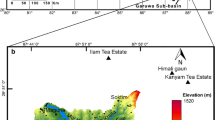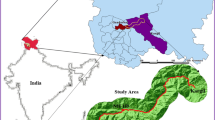Abstract
Landslide is more universal calamity in mountain areas. It is a threat to life and socio-economy. The ghat section Calicut–Nilampur–Gudalur State Highway 37 (SH-37) comes under the Survey of India toposheet 58A/7. It is important road network to connect Calicut. The study area is covered in 6.5 km ghat section of 103/6 to 109/8 km stone on SH 37. This study was carried out to prepare landslide susceptibility zonation (LSZ) mapping on 1:50,000 scale using frequency ratio model. Seventeen parameters such as elevation, slope, slope aspect, curvature, road buffer, drainage buffer, lineament buffer, land use, geomorphology, run-off, drainage density, drainage frequency, lineament density, lineament frequency, weathering condition, soil thickness and geology were considered as landslide-inducing factors. LSZ map was organized by manipulating association between the landslide persuade factors and old landslide using this model. Study area has grouped into five levels of susceptibility groups such as very low, low, moderate, high and very high. The LSZ map was validated by the old landslide record data collected from field. The landslide inventory percentage fall in very low hazard is 1.02%, 1.03% under low-susceptibility, 7.22% in moderate-susceptibility, 39.18% present in high-susceptibility and 51.55% noticed in very high-susceptibility zone, and using these data, the 18 rock vulnerable cut slopes were identified.











Similar content being viewed by others
References
Aditian, A., Kubota, T., & Shinohara, Y. (2018). Comparison of GIS-based landslide susceptibility models using frequency ratio, logistic regression, and artificial neural network in a tertiary region of Ambon, Indonesia. Geomorphology, 318, 101–111.
Anbalagan, R. (1992). Landslide hazard evaluation and zonation mapping in mountainous terrain. Engineering Geology, 32, 269–277.
Anbazhagan, S., & Ramesh, V. (2014). Landslide hazard zonation mapping in Ghat road section of Kolli hills, India. Journal of Mountain Science, 11(5), 1308–1325.
Anon. (1998a). Hill road manual. IRC:SP:48–1998.
Anon. (1998b). Bureau of Indian standard, preparation of landslide hazard zonation maps in mountainous terrain—guideline, part 2, Macro-zonation, IS:14496.
Anon. (2006). Manual of National land use and land cover mapping using multi-temporal satellite data. Hyderabad: National Remote Sensing Centre.
Anon. (2008). Rajiv Gandhi National Drinking Water Mission methodology manual for preparation of Groundwater prospects map. Hyderabad: National Remote Sensing Centre.
Baeza, C., & Corominas, J. (2001). Assessment of shallow landslide susceptibility by means of multivariate statistical techniques. Earth Surface Processes and Landforms, 26, 1251–1263.
Balamurugan, G., Ramesh, V., Francis, S., & Somnath, B. (2017). Comparison of probabilistic and expert-based models in landslide susceptibility zonation mapping in part of Nilgiris District, Tamil Nadu, India. Spatial Information Research, 25(6), 757–768.
Carrara, A. (1988). Landslide hazard mapping by statistical method: A black box model approach. In: Proceeedings of the workshop on natural disaster in European mediterranean countries. Perugia, Italy, Consiglio Nazionale delle Ricerche.
Dai, F. C., Lee, C. F., & Ngai, Y. Y. (2002). Landslide risk assessment and management: an overview. Engineering Geology, 64(1), 65–87.
Dolui, B., Yuvaraj, R. M., & Geetha, G. (2019). Landslide susceptibility mapping using AHP model in Nilgiri District. Thematics Journal of Geography, 8(12), 189–208.
Ganapathy, G. P., & Rajawat, A. S. (2015). Use of hazard and vulnerability maps for landslide planning scenarios: a case study of the Nilgiris, India. Natural Hazards, 77, 305–316.
Guzzetti, F., Carrara, A., Cardinali, M., & Reichenbach, P. (1999). Landslide hazard evaluation: a review of current techniques and their application in a multi-scale study, Central Italy. Geomorphology, 31, 181–216.
Huang, F., Yao, C., Liu, W., Li, Y., & Liu, X. (2018). Landslide susceptibility assessment in the Nantian area of China: a comparison of frequency ratio model and support vector machine. Geomatics, Natural Hazards and Risk, 9(1), 919–938.
Jenks, G. F. (1967). The data model concept in statistical mapping. International Yearbook of Cartography, 7, 186–190.
Kannan, M., Saranathan, E., & Anbalagan, R. (2011a). Macro landslide hazard zonation mapping—case study from Bodi-Bodimettu Ghat section, Theni District, Tamil Nadu—India. Journal Indian Society of Remote Sensing, 39(4), 485–496.
Kannan, M., Saranathan, E., & Anbalagan, R. (2011b). Evaluation of vulnerable zones in Bodi-Bodimettu Ghat section, Bodinayakkanur Taluk, Theni District, Tamil Nadu.. Indian Landslides, 4(1), 39–44.
Kannan, M., Saranaghan, E., & Anbalagan, R. (2013). Landslide vulnerability mapping using frequency ratio model: a geospatial approach in Bodi-Bodimettu Ghat section, Theni district, Tamil Nadu, India. Arabian Journal of Geosciences , 6, 2901–2913.
Kumar, R., & Anbalagan, R. (2015). Landslide susceptibility zonation of Tehri reservoir rim region using binary logistic regression model. Current Science, 108(9), 1662–1672.
Kumar, N., Balasundaram, N., & Meenambal, T. (2017). A study of factors influencing Landslide in Nilgiris, Tamil Nadu. International Journal of Civil Engineering and Technology, 8(8), 1011–1018.
Lee, S., & Pradhan, B. (2007). Landslide hazard mapping at Selangor, Malaysia using frequency ratio and logistic regression models. Landslides, 4, 33–41.
Lee, S., Choi, J., & Min, K. (2004). Probabilistic landslide hazard mapping using GIS and remote sensing data at Boun, Korea. International Journal of Remote Sensing, 125(11), 2037–2052.
Lillesand, T. M., & Kiefer, R. W. (1987). Remote Sensing and Image interpretation (p. 721). Chichester: John Wiley & Sons.
Mani, S., & Saranaathan, S. E. (2016). Hydrological parameters controls vulnerable Zones in Calicut—Nilambur—Gudalur Ghat section, Gudalur, The Nilgiris, Tamil Nadu. International Journal of ChemTech Research, 9(3), 248–253.
Mani, S., & Saranaathan, S. E. (2017), Landslide Hazard Zonation mapping on meso-scale in SH-37 Ghat section, Nadugani, Gudalur, The Nilgiris, India. Arabian Journal of Geosciences, 10(7), Article Number: 161.
Mantovani, F., Soeters, R., & van Western, C. J. (1996). Remote sensing techniques for landslides and hazard zonation in Europe. Geomorphology, 15, 213–225.
Naranjo, J. A., Scott, K. M., & Hildreth, W. E. (1997). Highly mobile catastrophic debris avalanche of Planchon-Peteroa volcanic complex, southern Andes, Chile: Puerto Vallarta, Mexico. International Association of Volcanology and Chemistry of the Earth’s interior General Assembly, Abstracts, p107.
Nithya, S. E., & Prasanna, P. R. (2010). An integrated approach with GIS and remote sensing technique for landslide hazard zonation. International Journal of Geomatics and Geosciences, 1(1), 66–75.
Pradhan, B., & Lee, S. (2010). Landslide susceptibility assessment and factor effect analysis: backpropagation artificial neural networks and their comparison with frequency ratio and bivariate logistic regression modelling. Environmental Modelling & Software, 25, 747–759.
Prasanna Venkatesh, S., & Saranaathan, S. E. (2018). Identification of landslide susceptibility zonation in CNG ghat section, Gudalur, The Nilgiris—using GIS based ANN/Multi criteria method. The International Archives of the Photogrammetry, Remote Sensing and Spatial Information Sciences, XLI I(5), 871–874. ISPRS TC V Mid-term Symposium “Geospatial Technology—Pixel to People”, 20–23 November. Dehradun, India. https://doi.org/10.5194/isprs-archives-XLII-5-871-2018
Rahaman, S. A., Aruchamy, S., & Jagankumar, R. (2014). Geospatial approach on landslide hazard zonation mapping using Multicriteria decision analysis: A study on Coonoor and Ooty, part of Kallar watershed, The Niligiris, Tamil Nadu. The International Achieves of the Photogrammetry, Remote Sensing and Spatial information Science, XL-8:1417–1422. ISPRS Technical Commission VIII Symposium, 09–12, December 2014, Hyderabad, India.
Raja, N. B., Cicek, I., Turkoglu, N., Aydin, O., & Kawasaki, A. (2017). Landslide susceptibility mapping of the Sera River Basin using logistic regression model. Natural Hazards, 85, 1323–1346.
Ramani, S. E., Pitchaimani, K., & Gnanamanickam, V. R. (2011). GIS based landslide susceptibility mapping of Tevankarai Ar sub-watershed, Kodaikkanal, India using binary logistic regression analysis. Journal of Mountain Science, 8, 505–517.
Ramli, M. F., Yusof, N., Yusoff, M. K., Juahir, H., & Shafri, H. Z. M. (2013). Lineament mapping and its application in landslide hazard assessment: a review. Bulletin of Engineering Geology and the Environment, 69(2), 215–233.
Ramesh, V., Mani, S., Baskar, M., Kavitha, G., & Anbazhagan, S. (2017). Landslide hazard zonation mapping and cut slope stability analyses along Yercaud ghat road (Kuppanur-Yercaud) section, Tamil Nadu, India. International Journal of Geo-Engineering, 8, 2.
Ramesh, V., & Anbazhagan, S. (2015). Landslide susceptibility mapping along Kolli hills Ghat road section (India) using frequency ratio, relative effect and fuzzy logic models. Environmental Earth Sciences, 73, 8009–8021.
Razavizadeh, S., Solaimani, K., Massironi, M., & Kavian, A. (2017). Mapping landslide susceptibility with frequency ratio, statistical index, and weights of evidence models: a case study in northern Iran. Environmental Earth Sciences, 76, 499.
Sarkar, S., & Kanungo, D. P. (2004). An integrated approach for landslide susceptibility mapping using remote sensing and GIS. Photogramm Eng Remote Sensing, 70(5), 617–625.
Sriramkumar, C., Saranathan, E., Gnanamanickam, V. R., & Nadage, B. S. (2006). Landslide zonation mapping—Konkan Railway, Ratnagiri Region, Maharastra. International Symposium On Geospatial Databases for Sustainable Development, Goa, India, September 27–30, IAPRS-SIS, 36(4), 582–586.
Saranathan, E., Rajesh Kumar, V., & Kannan, M. (2010). Landslide macro hazard zonation of the Yercaud Hill slope ghat section—km 10/4 to 29/6. Indian Landslides, 3(1), 9–16.
Saranathan, E., Ravindar, S., Chandrasekaran, R., Gopinath, K., & Kannan, M. (2011). Landslide susceptibility zonation for Kumuli Ghat section, Theni District, Tamil Nadu. Indian Landslides, 4(1), 45–50.
Saranaathan, S. E., & Mani, S. (2016). Landslide zonation mapping using multicriterion analysis-CNG 37 Ghat section, Nadugani, Gudalur Taluk, The Nilgiris—using geological factors. The International Journal of Earth Sciences and Engineering, 9(4), 885–887.
Sujatha, E. R., & Rajamanickam, V. (2011). Landslide susceptibility mapping of Tevankarai Ar sub-watershed, Kodaikkanal taluk, India, using weighted similar choice fuzzy model. Natural Hazards, 59, 401–425.
Sujatha, E. R., Rajamanickam, G. V., & Kumaravel, P. (2012). Landslide susceptibility analysis using probabilistic certainty factor approach: a case study on Tevankarai stream watershed, India. Journal of Earth System Science, 121, 1337–1350.
Tehrany, M. S., Kumar, L., Jebur, M. N., & Shabani, F. (2019). Evaluating the application of the statistical index method in flood susceptibility mapping and its comparison with frequency ratio and logistic regression methods. Geomatics Nat Hazards Risk, 10(1), 79–101.
Thennavan, E., & Ganapathy, G. P. (2020). Evaluation of landslide hazard and its impacts on hilly environment of the Nilgiris District—a geospatial approach. Geoenviron Disasters, 7, 3.
Vakhshoori, V., & Zare, M. (2016). Landslide susceptibility mapping by comparing weight of evidence, fuzzy logic, and frequency ratio methods. Geomatics Natural Hazards and Risk, 7(5), 1731–1752.
Varnes, D. J. (1981). Slope stability problems of the circum Pacific region as related to mineral and energy resource. In M. T. Halbouty (Ed.), Energy resources of the Pacific region (pp. 489–505). Tulsa, Okla: American Association of Petroleum Geologist.
Varnes, D. J. (1984). Landslide Hazard Zonation: A Review of Principles and Practice (pp. 1–63). International Association of Engineering Geology, UNESCO, Paris: Natural Hazards.
Zhang, Y. X., Lan, H. X., Li, L. P., Wu, Y. M., Chen, J. H., & Tian, N. M. (2020). Optimizing the frequency ratio method for landslide susceptibility assessment: a case study of the Caiyuan Basin in the southeast mountainous area of China. J Mountain Sci, 17(2), 340–357.
Zhuang, J., Peng, J., Zhu, X., Li, W., Ma, P., & Liu, T. (2016). Spatial distribution and susceptibility zoning of geohazards along the Silk Road, Xian-Lanzhou. Environmental Earth Sciences, 75, 711.
Acknowledgement
The authors thank Prof. R. Sethuraman, former Vice-Chancellor of SASTRA University, Thanjavur, for having given us facilities to carry out this work, Dr. Bhoop Singh, Advisor/Scientist G, NRDMS division, Department of Science and Technology, New Delhi, for the financial support for research project entitled ‘Kinematic analysis for planar failure conditions of rock slope along 6.5 Km Ghat Section of SH 37, Gudalur, The Nilgiris, Tamil Nadu’ and encouragement provided to carry out this work. The authors thank anonymous reviewers for their comments and suggestions to improve the quality of the research article.
Author information
Authors and Affiliations
Corresponding author
Additional information
Publisher's Note
Springer Nature remains neutral with regard to jurisdictional claims in published maps and institutional affiliations.
About this article
Cite this article
Saranaathan, S.E., Mani, S., Ramesh, V. et al. Landslide Susceptibility Zonation Mapping Using Bivariate Statistical Frequency Ratio method and GIS: A Case Study in Part of SH 37 Ghat Road, Nadugani, Panthalur Taluk, The Nilgiris. J Indian Soc Remote Sens 49, 275–291 (2021). https://doi.org/10.1007/s12524-020-01207-3
Received:
Accepted:
Published:
Issue Date:
DOI: https://doi.org/10.1007/s12524-020-01207-3




